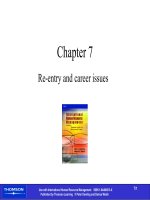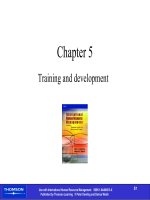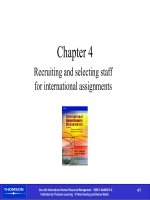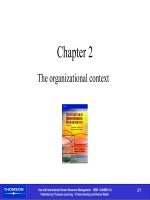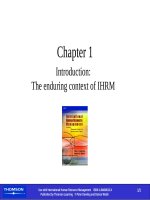International human resource management - Chapter 1 docx
Bạn đang xem bản rút gọn của tài liệu. Xem và tải ngay bản đầy đủ của tài liệu tại đây (1.5 MB, 18 trang )
Use with International Human Resource Management ISBN 1-84480013-X
Published by Thomson Learning © Peter Dowling and Denice Welch
1/1
Chapter 1
Introduction:
The enduring context of IHRM
Use with International Human Resource Management ISBN 1-84480013-X
Published by Thomson Learning © Peter Dowling and Denice Welch
1/2
Chapter objectives
In this introductory chapter, we establish the
scope of the textbook. We:
•
define key terms in international human resource
management (IHRM)
•
outline the differences between domestic and international
human resource management and the variables that
moderate these differences
(cont.)
Use with International Human Resource Management ISBN 1-84480013-X
Published by Thomson Learning © Peter Dowling and Denice Welch
1/3
Chapter objectives (cont.)
•
discuss trends and challenges in the global work
environment and the enduring context in which IHRM
functions and activities are conducted – including the way
in which forces for change affect the operations of the
internationalizing firm and have consequences for the
management of people in the multinational context.
Use with International Human Resource Management ISBN 1-84480013-X
Published by Thomson Learning © Peter Dowling and Denice Welch
1/4
Figure 1-1: Inter-relationships between approaches in the field
Use with International Human Resource Management ISBN 1-84480013-X
Published by Thomson Learning © Peter Dowling and Denice Welch
1/5
Figure 2-1: A model of IHRM
Use with International Human Resource Management ISBN 1-84480013-X
Published by Thomson Learning © Peter Dowling and Denice Welch
1/6
HR activities slide 1
•
Human resource planning
•
Staffing
–
Recruitment
–
Selection
–
Placement
•
Training and development
Use with International Human Resource Management ISBN 1-84480013-X
Published by Thomson Learning © Peter Dowling and Denice Welch
1/7
HR activities slide 2
•
Compensation
(remuneration)
and benefits
•
Industrial
relations
Figure 2-2: Stages of
internationalization
Use with International Human Resource Management ISBN 1-84480013-X
Published by Thomson Learning © Peter Dowling and Denice Welch
1/8
What is an expatriate?
•
An employee who is working and temporarily residing in a
foreign country
•
Some firms prefer to use the term ‘international assignees’
•
Expatriates are PCNs from the parent country operations,
TCNs transferred to either HQ or another subsidiary, and
HCNs transferred into the parent country
Use with International Human Resource Management ISBN 1-84480013-X
Published by Thomson Learning © Peter Dowling and Denice Welch
1/9
Figure 1-3: International assignments create expatriates
Use with International Human Resource Management ISBN 1-84480013-X
Published by Thomson Learning © Peter Dowling and Denice Welch
1/10
Differences between domestic
and international HRM
•
More HR activities
•
The need for a broader perspective
•
More involvement in employees’ personal lives
•
Changes in emphasis as the workforce mix of expatriates
and locals varies
•
Risk exposure
•
Broader external influences
Use with International Human Resource Management ISBN 1-84480013-X
Published by Thomson Learning © Peter Dowling and Denice Welch
1/11
Figure 1-4: Variables that moderate differences between domestic
and international HRM
Use with International Human Resource Management ISBN 1-84480013-X
Published by Thomson Learning © Peter Dowling and Denice Welch
1/12
The ‘top ten’ multinationals
1. Rio Tinto
(UK/Australia)
2. Thomson
Corporation
(Canada)
3. ABB (Switzerland)
4. Nestlé (Switzerland)
5. British American
Tobacco (UK)
6. Electrolux (Sweden)
7. Interbrew (Belgium)
8. Anglo American (UK)
9. AstraZeneca (UK)
10. Philips Electronics
(The Netherlands)
UNCTAD Index of Transnationality
Use with International Human Resource Management ISBN 1-84480013-X
Published by Thomson Learning © Peter Dowling and Denice Welch
1/13
Figure 1-5: Factors influencing the global work environment
Use with International Human Resource Management ISBN 1-84480013-X
Published by Thomson Learning © Peter Dowling and Denice Welch
1/14
Forces for change
•
Global competition
•
Growth in mergers, acquisitions and alliances
•
Organization restructuring
•
Advances in technology and telecommunication
Use with International Human Resource Management ISBN 1-84480013-X
Published by Thomson Learning © Peter Dowling and Denice Welch
1/15
Impacts on multinational
management
•
Need for flexibility
•
Local responsiveness
•
Knowledge sharing
•
Transfer of competence
Use with International Human Resource Management ISBN 1-84480013-X
Published by Thomson Learning © Peter Dowling and Denice Welch
1/16
Managerial responses
•
Developing a global ‘mindset’
•
More weighting on informal control mechanisms
•
Fostering horizontal communication
•
Using cross-border and virtual teams
•
Using international assignments
Use with International Human Resource Management ISBN 1-84480013-X
Published by Thomson Learning © Peter Dowling and Denice Welch
1/17
Chapter summary
This chapter has established the scope of this
book. We have:
•
Defined international HRM and the term ‘expatriate’.
•
Discussed the differences between domestic and
international HRM – looking at six factors: more HR
activities, the need for a broader perspective, more
involvement in employees’ personal lives, changes in
emphasis as the workforce mix of expatriates and locals
varies, risk exposure and more external influences.
(cont.)
Use with International Human Resource Management ISBN 1-84480013-X
Published by Thomson Learning © Peter Dowling and Denice Welch
1/18
Chapter summary (cont.)
•
Examined what we have called the enduring context of IHRM.
The focus is on the current global work environment, looking
at the forces for change that have prompted managerial
responses that have implications for the way in which people
are being managed in multinationals at the turn of the 21st
century. However, we have made a brief comparison with the
situation that confronted a 14th-century merchant as a way of
drawing out some of the constants in international business.
This treatment has enabled us to provide an overview of the field
of IHRM and establish how the general environment affects
IHRM. The next chapter examines the organizational context
where we explore how IHRM activities are determined by, and
influence, various internal changes as the firm internationalizes.


